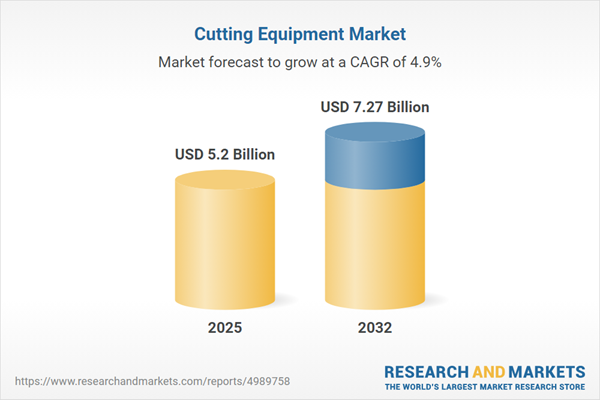Speak directly to the analyst to clarify any post sales queries you may have.
The cutting equipment market is evolving rapidly, driven by advancements in technology, shifting trade environments, and industrial demand for greater precision. Senior decision-makers require nuanced market intelligence to navigate and capitalize on emerging trends in this dynamic industry.
Market Snapshot: Cutting Equipment Market Size and Growth
The cutting equipment market grew from USD 4.96 billion in 2024 to USD 5.20 billion in 2025. Projected to expand at a CAGR of 4.88%, the market is expected to reach USD 7.27 billion by 2032. This sustained momentum reflects the ongoing integration of digital manufacturing technologies, growing demand for customization, and the adoption of versatile, high-performance systems across global industries.
Scope & Segmentation: Coverage of Industry Segments, Technologies, and Regions
This report delivers a thorough analysis of the cutting equipment market, offering a granular breakdown designed for strategic planning:
- Equipment Types: Fiber laser, CO₂ laser, Nd:YAG laser machines; oxyfuel; plasma (conventional, high-definition); abrasive and pure waterjet machines.
- Power Sources: Electric, hydraulic, and pneumatic-driven systems.
- Control Types: CNC-controlled and manual configurations.
- Machine Sizes: Small, medium, and large-platform equipment tailored for varying production setups.
- End User Industries: Aerospace, automotive, construction (commercial, residential), industrial fabricators, job shops, shipbuilding.
- Applications: Pipe, plate, profile, sheet, and tile cutting solutions.
- Distribution Channels: Online procurement platforms and traditional offline dealerships.
- Geographic Regions: Americas (including North America, Latin America), Europe, Middle East & Africa, and Asia-Pacific, with detailed country-level analysis.
- Companies Covered: TRUMPF GmbH + Co. KG, Amada Co., Ltd., Bystronic Laser AG, Yamazaki Mazak Corporation, Mitsubishi Heavy Industries, Ltd., DMG Mori AG, Messer Cutting Systems GmbH, Prima Industrie S.p.A., Hypertherm, Inc., Flow International Corporation.
Key Takeaways: Strategic Insights for Leadership
- Emerging automation and digital integration are redefining operational workflows, enabling precision and productivity improvements across industries.
- Industry adoption of sensor-based monitoring and IoT platforms supports real-time data analysis, driving sustained operational efficiencies and predictive maintenance strategies.
- Equipment manufacturers are employing modular machine designs and digital service offerings to address evolving client requirements and maintain competitive differentiation.
- Supply chain enhancements and regionalized manufacturing strategies are gaining traction, driven by the need to mitigate input cost volatility and tariff-based disruptions.
- End users are prioritizing investment in multimodal platforms that can flexibly process a broad range of materials, responding to growth in customization and advanced material applications.
- Sophisticated CNC control systems and adaptive power sources are supporting sustainability goals by delivering energy savings and high-quality cutting performance.
Tariff Impact: Navigating the Post-2025 Trade Environment
New tariffs imposed in 2025 have triggered significant shifts in sourcing and supply chain strategies. Manufacturers are reassessing global procurement, investing in risk assessment tools, and pursuing vendor-managed inventory solutions. Many end users are investing in localized assembly and production, aiming to safeguard margins and ensure business continuity. These shifts are also spurring innovation in component design and encouraging collaborative supplier relationships.
Methodology & Data Sources
Research findings draw on a rigorous multi-phase approach, including executive interviews, extensive secondary data analysis, and advanced quantitative modeling. Proprietary databases and industry benchmark reports inform the data, with strict verification protocols ensuring reliable, actionable insights.
Why This Report Matters: Strategic Value for Decision-Makers
- Enables leaders to confidently identify growth opportunities and respond to evolving market and regulatory demands.
- Equips teams with deep segmentation, regional, and competitive intelligence for informed strategic planning and investment.
- Offers actionable recommendations focused on operational efficiency, technology integration, and supply chain resilience.
Conclusion
By providing authoritative coverage of segmentation, technologies, regional dynamics, and industry strategies, this report supports executives in developing targeted, future-ready approaches. Informed decisions will be vital for capturing value and sustaining growth in the rapidly advancing cutting equipment market.
Additional Product Information:
- Purchase of this report includes 1 year online access with quarterly updates.
- This report can be updated on request. Please contact our Customer Experience team using the Ask a Question widget on our website.
Table of Contents
3. Executive Summary
4. Market Overview
7. Cumulative Impact of Artificial Intelligence 2025
Companies Mentioned
The companies profiled in this Cutting Equipment market report include:- TRUMPF GmbH + Co. KG
- Amada Co., Ltd.
- Bystronic Laser AG
- Yamazaki Mazak Corporation
- Mitsubishi Heavy Industries, Ltd.
- DMG Mori AG
- Messer Cutting Systems GmbH
- Prima Industrie S.p.A.
- Hypertherm, Inc.
- Flow International Corporation
Table Information
| Report Attribute | Details |
|---|---|
| No. of Pages | 183 |
| Published | October 2025 |
| Forecast Period | 2025 - 2032 |
| Estimated Market Value ( USD | $ 5.2 Billion |
| Forecasted Market Value ( USD | $ 7.27 Billion |
| Compound Annual Growth Rate | 4.8% |
| Regions Covered | Global |
| No. of Companies Mentioned | 11 |









